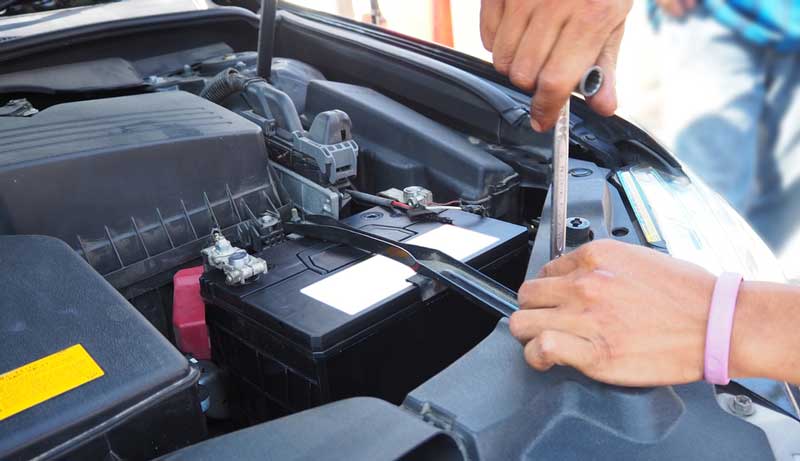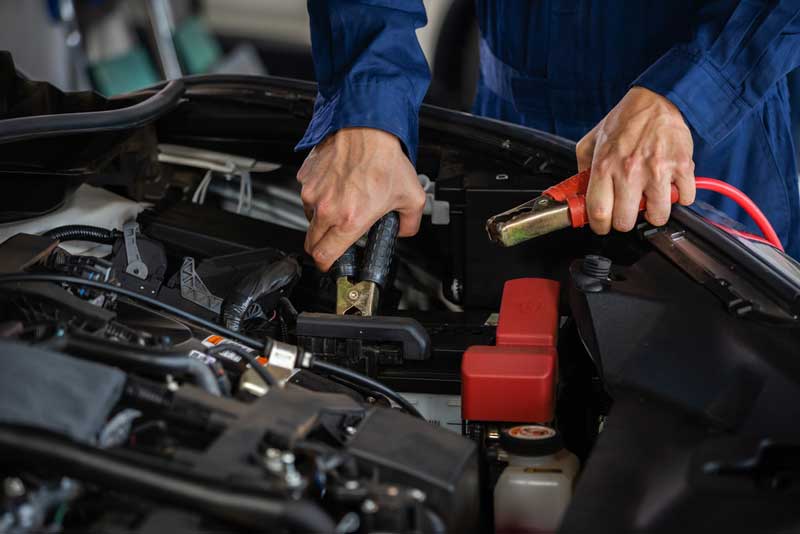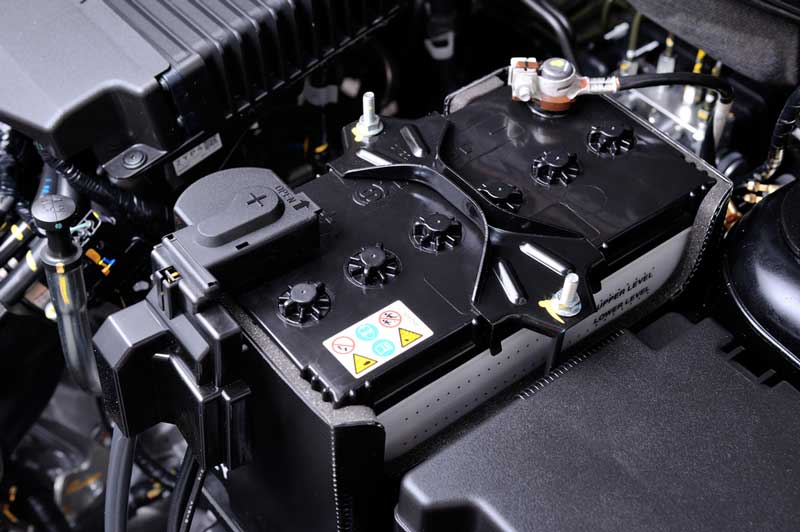The battery of an automobile appears to be simple to connect or unplug. However, you might want to know, is it positive or negative first when connecting a battery?
Despite how straightforward it is to only remove or attach the battery wire ropes(cables) to/from the terminals, it is among the trickiest procedures to carry out.
When connecting the battery wire ropes(cables) to the terminals, one critical decision is attaching the positive or negative cable first. The process of disconnecting calls for the same kind of reflection.
This article will help you find an easy answer to your questions. You will learn the proper connection method’s significance and the risks associated with using a poor strategy.
Read on!
Is it Positive Or Negative First When Connecting a Battery?
“First, the positive and then the negative. When you want to disengage the cables from the old battery, disconnect the negative first before the positive. Then, connect the new battery following reverse order, the positive then negative.”
How Does a Car Battery Work?
Lead-acid batteries are the type found in cars. Each of its six cells is divided into positive & negative plates. There is an electrolyte between the plates (sulphuric acid & water).
The alternator creates a current of electricity while the motor is operating and replenishes energy in the battery. The current of electricity flows between the positive & negative terminals.
The battery keeps the vehicle’s electrical system running when the motor is off (for example, radio, lights, etc.).
This is accomplished by allowing electrons to flow from the electrolyte to the (-) negative plate of the battery. This causes a current flow to start from the (+) positive side & go to the (-) negative side.

What Would Happen When You Hook Battery Cables Up Backwards?
In your car’s electrical system, fuses act as a safety measure. By severing the circuit in the event of a current overload, they are intended to safeguard your car against damage.
The fuse will explode if you connect the battery wire ropes(cables) backward, cutting off the circuit’s ability to conduct electricity. Your car’s electrical system will be shielded from harm by doing this.
What Would Happen if You Hook a 12V Battery in Reverse?
Your car’s electrical system won’t be harmed if you connect a 12V battery backward. The battery won’t be able to charge, however. This is due to the battery’s flipped polarity, which will cause electrons to flow against their natural direction.
Which Car Battery Terminal to Connect, Positive or Negative First?
Without a good reference, deciding whether to connect a battery’s positive or negative terminal can be challenging. So here is the solution:
When connecting/attaching a battery, connect the (+) positive connector before the (-) negative side.
Why should the (+) positive side be connected first? It is THE BIG QUESTION. The safety it offers during the connection/joining process is the only reason.
If you connect the positive terminal before the negative, you might ignite a large arc or spark through the wrench or spanner you’re using to tighten the positive wire rope(cable) if it makes contact with the metallic part of the vehicle.
Therefore, properly link the positive wire rope(cable) to the (+) positive side of the battery before fastening the negative wire rope(cable) in place on the negative terminal of the battery to prevent abrupt electrocution or fire outbreak.
Also Read: How to Test a Solenoid
Which Car Battery Terminal to Remove, Positive or Negative First?
Again, while removing the battery, it can be challenging to remember which is positive and which is negative. While disconnecting a battery, the wires are not just simple wiring which can be pulled out at will.
Remove the positive battery terminal last. Gently remove the negative battery terminal first. The wrench/spanner you use to remove the positive wire rope(cable)could come into contact with the car’s body (metallic surface) or engine block, causing a strong spark that could destroy the battery if the positive terminal is disconnected before the negative.
Connect the car’s battery in the same manner but in reverse. That is to say, the positive side is used to connect, while the negative side is used to disengage.
What Could cause Damage to a Car Battery?
- A car battery may be harmed by a variety of factors, in addition to incorrect terminal connections. A battery can also be harmed by a deep drain, overcharging, and very hot or very cold conditions.
- When the system’s voltage rises above 14.0V, overcharging occurs. Incorrect voltage regulation or an erroneous alternator may cause this.
- Low battery voltage, often known as deep discharge. This may occur if the electrical system is overworked (for example: by heated seats, lights, etc.) Or if the vehicle sits idle for an extended amount of time or
- Due to the electrolyte’s propensity to boil or freeze, extreme temperatures can harm batteries. The battery needs to be kept warm during cold weather (although not too hot).
It’s crucial to keep your battery cold when it’s hot outside.
When Should You Change a Car Battery?
Your automobile battery needs to be changed, even if you take proper care of it. An automobile battery has a 3-5years typical life span. You might need to change your battery earlier than expected if you reside in a hot area.
Replace your batteries if you find that your electrical system isn’t performing as well as it did before or that the automobile is hard to start. To have the battery tested for your vehicle, you can bring it to a skilled technician or a vehicle parts retailer.
Annual testing of your automobile battery is a nice idea if it is older than three years. This will assist you in avoiding getting stuck somewhere with a depleted battery.
Always attach the positive side first when attaching a car battery; as such, your battery & electrical system will not be harmed.
How to Increase The Lifespan of a Battery
The following actions will help you increase the life of your automobile battery:
- Maintain a corrosion-free environment for the battery.
- To prevent corrosion, maintain tight terminals.
- Continue to charge the battery.
- Prevent deep discharge.
- Avert extreme temperatures.
- Replace the battery every three to five years.
Installing a Car Battery
Anyone can install a vehicle battery because it is a straightforward operation. Just follow the steps below:
- The old battery’s negative terminal should be disconnected.
- The old battery’s positive terminal should be disconnected.
- Remove the vehicle’s old battery.
- Put the new battery inside the vehicle.
- Connect the new battery’s positive terminal.
- Connect the new battery’s negative terminal.
All done! A new automobile battery has been successfully installed. Make sure to care for it properly moving forward so it will last many years.
Do Battery Cables come Color-coded?
Yes, battery wires often have different colors. Normal colors for the positive & negative terminals are red and black, respectively. To be sure, it’s wise to consult the owner’s manual for your particular vehicle.
It is important to remember that the polarity of the sides and the wire colors may not always match.
How to Replace Battery Cables
A new battery cable may be necessary depending on your car’s year, model, and make. For instructions on how to change your battery wires, consult the user handbook. You can find the details required to change your battery wires below correctly.
To begin, you will require equipment like a wrench set, safety glasses, goggles, gloves, wheel chocks, jacks, and jack stands. The procedures to take are listed below.
- Put on your gloves and safety glasses.
- To make additional room, use a jack stand to lift your automobile and a second one to hold it in place.
- First, remove the negative wire rope(cable) from the battery, and make sure to keep it away from the battery.
- The battery’s positive cable should be disconnected.
- Remove every connector keeping the car’s battery firmly in place.
- The car’s battery hold-down devices and connectors must all be removed.
- Take the battery out of the vehicle.
- After removing the battery, you can observe how the wire ropes(cables) attach to the battery.
- Remove the cable from the engine system by releasing each hold-down connector holding it to the vehicle.
When Can One Disconnect a Car Battery?
You can unplug a vehicle battery anytime. However, it’s essential to keep in mind that when the battery is unplugged, some vehicles’ systems will require it to be reset. To learn more, go to your car’s owner’s manual.
In general, it’s recommended to detach the battery before leaving your automobile unattended for a long time, so the battery will not be drained.
Also, if you’ll be operating on your car’s electrical system, you should disconnect the battery. Inadvertent damage & shocks to your vehicle will be avoided by doing this. Whenever you start your automobile, be sure the battery is connected.
How Can I Jump-start a Car?
You can use a vehicle with a functioning battery to jump-start your own when the battery dies. Just follow these guidelines:
- A functional battery should be connected to a dead battery’s (+) positive side.
- Connect or join the dead battery’s negative terminal to the (-) negative side of the active battery.
- With a functional battery, start your car.
- Allow the vehicle to idle for a while.
- From the dead battery’s negative terminal, disconnect it.
- disconnect the dead battery from the positive terminal.
- Your car is ready to start.
- Follow these instructions again if your automobile won’t start. You might need a new battery if your vehicle still won’t start.
Anyone can quickly jump-start an automobile thanks to its simplicity. Just make sure to follow all safety guidelines. Never handle a battery’s terminals while it is attached.

Which Terminal Should I Connect First When Jump-Starting a Car?
You have to join the positive terminals of the live battery and the live battery’s positive terminal when jump-starting a vehicle.
Following that, you have to join the negative side of a live battery with a grounding location on the vehicle (for example. chassis). The circuit will be complete and electrical current will be able to move from the active to the inactive battery.
Should I Turn Off Your Car Before Removing the Jumper Cables?
When your car’s engine has started, don’t turn it off before disconnecting the booster/jumper cables. You can have trouble starting the engine without the booster/jumper cables connected, especially if the depleted battery hasn’t been charged.
Therefore, disconnect the jumper connections while the engine is still running. While detaching the cables, ensure that no clamps come in contact with one another.
The negative wire rope (cable) should be taken out before the (+) positive wire rope(cable). If you’re wondering whether the red is good or bad, note that Black denotes negativity, while red denotes positivity.
Also Read: How Long Does an Alternator Last
Frequently Asked Questions – Positive Or Negative First When Connecting a Battery
Why do you connect the positive terminal first?
Positive must come first because negative won’t spark and has less potential. The likelihood of arcing or sparking & fusion increases with voltage. In an automobile, there is a chance that an arc could strike you if the negative is connected first & you are in contact with any metal parts of the vehicle. Your body is integrated into the system.
What happens if you connect a car battery negative first?
The ground cable, designated as negative (-), can be securely disconnected first without the risk of sparking because it’s always linked to the body metal or frame. The positive wire rope(cable) should always be reconnected before the negative wire rope(cable).
Do you connect red or black first?
Start by connecting the red jumper wire ropes(cables). One red wire rope(cable) should be clamped to the battery’s positive side if it won’t start. The other red clamp should then be connected to the (+) positive terminal of the operational battery. Next, secure a single black wire rope(cable) to the (-) negative terminal of the working battery.
Why do you connect red first?
If the second red clamp were unintentionally dropped and made contact with that vehicle’s structure, connecting the red side to the depleted battery first will limit harm.
Why is the negative terminal disconnected first?
The negative terminal of your battery must be disconnected first; removing the positive side could result in a short circuit.
Why don’t you connect the negative when jumping a car?
The negative (-) end on your depleted battery should never have the black wire rope(cable) connected. Due to the possibility of an explosion, this is extremely risky.
What happens if you hook up negative to positive?
Reversing the battery terminal connections can seriously harm the battery, the electrical parts, & even you. An automobile battery uses twelve volts (12V) of voltage at each terminal.
Do you connect red to red and black to black?
The battery’s positive post should first be connected to the red clip on the charger. Connect the battery’s negative post to the charger’s black clip. Connect the red & black after charging, then unplug them both.
Conclusion – Positive Or Negative First When Connecting a Battery
Handling electrical or mechanical components with a compromised level of safety can be dangerous. The impact can seriously harm the part & other connected components or hurt the user. It serves no purpose to consider if anything is negative or positive before attaching or removing a car battery.
Refer to your owner’s manual & follow the instructions inside instead. If not, you should consult a professional and use the advice you’ve just read. Please share this post with anyone you know who is interested in quickly becoming a do-it-yourselfer. They will learn how to attach and disconnect the battery with its guidance.

